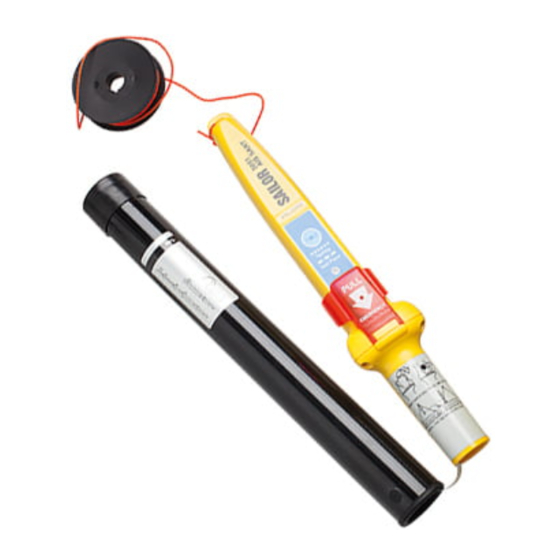
Table of Contents
Advertisement
Advertisement
Table of Contents

Summary of Contents for Thrane&Thrane Sailor 5051 AIS SART
-
Page 2: Safety Notices
Safety notices WARNING: An AIS SART is an emergency radio beacon. Operate only in situations of imminent danger to life. CAUTION: False alerts endanger lives and cause disruption to Search and Rescue services, deliberate misuse of the AIS SART could result in penalty. CAUTION: If the anti-tamper tab is broken, the SART is not compliant with SOLAS regulations and must be repaired or replaced. -
Page 3: Product Registration
IN EMERGENCY The AIS SART is a locating radio beacon for use only in emergency situations. False alerts endanger lives; help prevent them by understanding how to look after and correctly operate the AIS SART. Introduction Thank you for purchasing the AIS SART ‘ search and rescue locating device’ . The AIS SART is designed to assist in survivor craft location during search and rescue operations. - Page 4 Overview An AIS SART is intended to be a one-shot device, once activated will transmit Antenna emergency alerts for at least 96 hours. Red LED The key components of the AIS SART: 1. Hanger eye Inside life raft attachment point, use the lanyard cord to tether the AIS SART to the survival craft.
- Page 5 AIS SART pictured left is ready for deployment with the mounting pole fully extended. The activated AIS SART should be positioned upright and with a clear view of the sky. Do not obstruct the GPS zone marked on the side. The AIS SART should be arranged to be manually erected when the liferaft is deployed.
-
Page 6: Deployment Procedure
Deployment procedure 1. Lift stowage bag off its wall mounting bracket 2. Carry to liferaft using the strap provided 3. Open bag and remove the SART 4. Fold the pole down and insert the SART into the top of the pole 5. - Page 7 Page 6...
-
Page 8: Activation Procedure
Activation procedure Break-off the protective anti-tamper tab to gain access to the ‘ ON’ button beneath. . Press the ‘ ON’ button The Red LED indicator light will start to flash every few seconds Page 7... - Page 9 Red LED indication (AIS SART ON) 1 flash every 3.5 seconds The first AIS transmission is made after 50 seconds. This short delay allows time to switch off the AIS SART, if activated in error. GPS position fix indication GPS good A good GPS position fix is indicated by the Red LED signalling a long flash every minute.
-
Page 10: Deployment Guidelines
Deployment guidelines The AIS SART will work best when the top section has an unobstructed view of the sky. Do your best to maximise the sky view. The antenna datum marked on the pole section should be positioned more than one metre above sea level when the AIS SART is deployed. Tie the securing lanyard to the survival craft to avoid loss of the AIS SART. - Page 11 Self-test of the AIS SART Self test button Press and hold for 2 seconds to start the self-test routine. RED LED indicates self test in progress. It is recommended to self-test the AIS SART annually; more frequent self-testing can put unnecessary drain on the battery.
- Page 12 Refitting into the bulkhead bracket Fit the AIS SART and accessories inside the stowage case and close the cover and lid. Bracket Align stowage bag over bracket hooks and drop into place. Secured the strap handle around the base of the bag. Page 11...
-
Page 13: Bulkhead Bracket Installation
Bulkhead bracket installation The AIS SART portable stowage case should be located where it will not hinder day-to-day operations. Chose a protected location away from the extreme effects of the weather and protected from powerful vessel wash down hoses. Where possible, position the AIS SART adjacent to the ship’... -
Page 14: Routine Maintenance
Dealing with a transmitting AIS SART In the unlikely event that the AIS SART develops a fault and will not turn off you can prevent its transmissions by removing the lower battery section. To do this, undo the three fixing screws located around the main body. -
Page 15: Spare Parts
Spare parts Item Contents 92-057-003A Battery kit Battery pack and sealing kit 92-051A Anti tamper tab kit Switch cover and sealing kit 92-052-003A Storage case Empty case with packing insert. 92-053A Wall mounting kit Bracket and fixings 92-054A Lanyard Coiled 10m lanyard 92-055A Pole kit Pole with fitting parts 92-059-003A User Manual... -
Page 16: Specifications
Specifications Type IMO AIS SART Non float free Operation Manual activation switch Protected by anti tamper cover. Checks transmitter, battery, Self test GPS and indicators. AIS1, 161.975 MHz AIS Transmitter Operating frequency AIS2, 162.025 MHz Power output 1 W EIRP AIS message type 1, 14 Modulation... -
Page 17: End Of Life Statement
Stowage case AIS-SART before deployment End of Life Statement At the end of the products useful life, it is vital that the battery is removed from the main body of the AIS SART to prevent false alerts. False alerts cause expensive disruption to Search and Rescue services and may endanger lives as a consequence.



Need help?
Do you have a question about the Sailor 5051 AIS SART and is the answer not in the manual?
Questions and answers